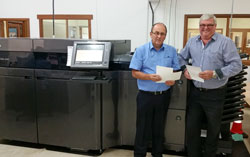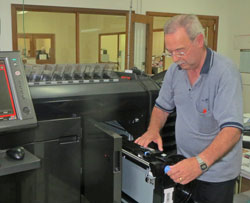Geelong-based schools photography specialist Arthur Reed Photos (ARP) has commissioned the second Australian Canon DreamLabo 5000 installation for its in-house production facility, after considering a range of options.

The first Australian DreamLabo, which handles in-house work as well as third party orders from businesses such as Canon PhotoPICO and Ted’s Cameras, was installed by Port Melbourne-based photo services operation PictureWorks in 2012.
The 7-colour DreamLabo 5000 can print at up to 12-inches wide.The printhead delivers high-speed one-pass printing, requiring only a single pass of the printing paper while the print head remains in a fixed position. Printing resolution is up to 2400x1200dpi. Automatic double sided printing is a standard feature.
It will produce 1000 (single-sided) 8×10 prints per hour, which is what ARP is primarily using it for.
The DreamLabo allows paper and ink tank replacement during printing, reducing downtime. It also turns itself on each morning before staff arrive, so they don’t have to wait while it warms up. Calibration is minimal compared to silver halide minilabs.

Arthur Reed was seeking a solution which in quality terms was ‘as close as possible to silver halide’ to replace its ageing fleet of 5 AgfaDLabs. These had been used for the photographic print component of its schools packages for the last 10 years.
Maintenance costs on the old DLabs was running at close to $40K per year, with associated downtime. It was time to seek an alternative, while not sacrificing the silver halide photographic quality the DLabs produced. The Agfa machines also only averaged around 400 8x10s an hour; so since the arrival of the DreamLabo, the working day has become shorter for production staff.
‘We believe the DreamLabo produces the closest thing to silver halide,’ said Arthur Reed CEO, Mark Thomas. ‘If anything, quality has gone up, and wastage has gone down massively.’
He added that in the four months the new printer has been operating, ARP has put around 200,000 orders through it, ‘and not one complaint’
So if Arthur Reed was seeking a ‘silver halide-like’ solution, why not another fleet of wet minilabs, or a high speed commercial AgX printer, such as a ZBE Chromira (distributed by IPS).
‘I wasn’t interested in silver halide,’ said Mark ‘The price of silver halide paper has always been relatively cheap compared to anything else, but I believe that with more people like us going digital, the price has to rise as silver halide loses market share. Whereas the cost of inkjet consumables is going to come down.’
Another alternative would have been a stable of lower output drylabs as offered by Nortitsu, Epson, Fujifilm or DNP.
‘To get the same output we would have needed to daisy-chain seven or eight together. That’s very noisy and it would have meant staff were up and down loading paper and ink for seven or eight machines. It would have given us some redundancy, but the workflow would have been a nightmare.’
So what about a digital press such as an HP Indigo? Last year leading Victorian pro lab NuLab raised eyebrows when it entirely abandoned silver halide photo printing, opting for Indigo digital presses to replace its fleet or 10 Fujifilm Frontiers.
‘Indigos do a great job but primarily, from our point of view, for photo books The difficulty we see is it’s just a press by itself so you need offline finishing to do what you want with it,’ said Mark.
‘I know some of our competitors have gone the Indigo way for producing their school packages as well, but then you need XY cutters and you have to put in a lot of different mechanisms and workflow to get the same result.
‘We just use the DreamLabo to make 10×8 prints. There’s no trimming, nothing. With all the other options you have to put in other workflow solutions. We were also concerned about image quality. We are selling to school and graduation people, and they want to see a photographic product.’
‘The DreamLabo 5000 is now gaining recognition, globally, as a new level of quality for high volume photo printing. The quality of the output has impressed some of the most colour conscious photographers in Australia,’ said Vishal Gohel, product manager for the DreamLabo 5000 at Canon Australia.
‘When we combine this with simple calibration, ergonomic workflows and a high level of reliability, the DreamLabo becomes a real business opportunity for customers that cater for this market.’
ARP’s Mark Thomas said that costs were yet another consideration in the decision to go with the DreamLabo. ‘You are looking at $1 million for machinery and offline equipment to achieve the same result as the Dreamlabo.
‘So there were three things – image quality, cost and offline options to trim, collate and all the rest of it.’
He said that in its basic configuration as used at ARP, the Dreamlabo was surprisingly cost effective compared to silver halide.
‘It will pay itself off in three years, possibly earlier. But we’ve got our return now. The DLabs were costing a fortune – probably about $30 – $40K per year, and the quality was dropping. So in terms of this thing returning on its investment – it’s already doing it. But in dollar terms, probably two to three seasons.’
The large ARP facility, in the Geelong suburb of Grovedale, also runs two Canon wide-format printers, and two Fuji Xerox high-volume digital laser printers, married to Plockmatic finishing and binding equipment for photo books and the like. Colour correction, design and packaging is all handled in-house, and ARP also has around 20 school photographers based at Grovedale. There’s a core staff of around 50, rising to 90 during peak times.
It’s been a big six months for the 55-year old business. As well as the DreamLabo installation, ARP last year took over the Victorian schools business of FotoMakers, and just a few weeks ago acquired Southam Studios, a specialist in graduation photography with client universities around Australia, as well as several campus’ in Asia.
Canon will be showcasing a variety of photobooks and photographs printed on the DreamLabo at PrintEx in Sydney. PrintEx is the premier printing exhibition in Australia and occurs every four years and takes place from May 13 – 15. Visit the Canon stand or call 1300 363 440 for more details.





Be First to Comment